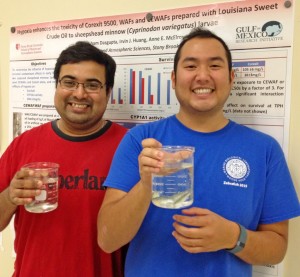From “Study Shows Hypoxia and Dispersed Oil May Increase Fish Mortality” from Gulf of Mexico Research Initiative (GoMRI)
Scientists conducted experiments to determine the effects of hypoxia (reduced oxygen conditions), a seasonal occurrence in the northern Gulf of Mexico, and oil spill contaminants on sheepshead minnow larvae.

Subham Dasgupta (left) and Irvin Huang (right) used this glove box to create hypoxic conditions for this study. (Photo provided by Anne E. McElroy)
Hypoxia as a co-stressor with Corexit® 9500 or Corexit-dispersed oil reduced larvae survival by 80% to 90%. There were no significant effects observed to the larvae exposed to hypoxia and oil or to hypoxia alone. They published their findings in the open access journal Public Library of Science (PLoS) One: Hypoxia enhances the toxicity of Corexit EC9500A and chemically dispersed Southern Louisiana Sweet Crude Oil (MC-242) to sheepshead minnow (Cyprinodon variegatus) larvae.
Dispersed oil from the Deepwater Horizon spill entered areas in the Gulf of Mexico that experience hypoxia, possibly causing additional stress to some marine organisms. Previous studies have demonstrated enhanced toxicity to larval and juvenile fish exposed to oil or hypoxic conditions. Other studies have established that dispersant can enhance toxicity of polycyclic aromatic hydrocarbons. The researchers in this study exposed sheepshead minnow larvae to hypoxic conditions and Corexit® 9500, an oil-water mixture, and a dispersant-oil-water mixture to better understand their combined interactions with early life stage fish.

Subham Dasgupta (left) and Irvin Huang (right) gave a poster presentation about their research at the 2015 Gulf of Mexico Oil Spill & Ecosystem Science conference. Here, they are holding beakers with early life stage fish similar to those used in their study. (Photo provided by Anne E. McElroy)
The study’s corresponding author, Anne McElroy, explained that the interactive toxicity of chemicals associated with oil spills and hypoxia is an important phenomenon to understand, “Although the effects of both oil and hypoxia are well studied, their combined effects are less well understood.” She continued, “Our findings clearly showed that under hypoxic conditions, early life stage fish are much more sensitive to dispersant and especially chemically dispersed oil, with mortality occurring after exposure to much lower concentrations than under ambient oxygen levels.”
Detailed studies to better understand why the combined effects are worse than exposure to either stressor on its own are already underway. The team noted that research on mechanistic pathways associated with sublethal impacts should aid in the understanding of potential oil spill risks in the context of variations in environmental conditions.
The study’s authors are two Stony Brook Ph.D. students, Subham Dasgupta and Irvin J. Huang, and Anne E. McElroy.
************
This research was made possible in part by a grant from the Gulf of Mexico Research Initiative (GoMRI) to Mississippi State University for their project “Characterizing the Composition and Biogeochemical Behavior of Dispersants and Their Transformation Products in Gulf of Mexico Coastal Ecosystems.”
GoMRI is a 10-year independent research program established to study the effect, and the potential associated impact, of hydrocarbon releases on the environment and public health, as well as to develop improved spill mitigation, oil detection, characterization and remediation technologies. An independent and academic 20-member Research Board makes the funding and research direction decisions to ensure the intellectual quality, effectiveness and academic independence of the GoMRI research. All research data, findings and publications will be made publicly available. The program was established through a $500 million financial commitment from BP. For more information, visit http://gulfresearchinitiative.org/.





You must be logged in to post a comment.